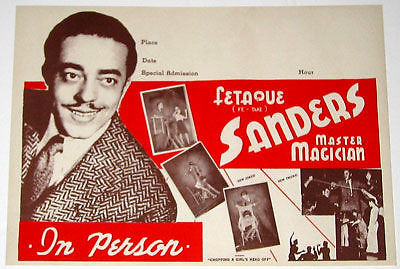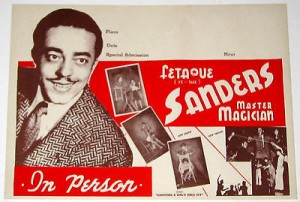
This week’s open thread’s focused on some lesser known but famous in the magic world, black magicians.
Fetaque Sanders (1915-1992) toured with the USO during World War II, performing for African American troops in the then-segregated US Armed Forces. After the war, Sanders continued to perform his magic act until 1962.He toured the United States for 25 years entertaining African-American children with a show of magic and comedy, the likes of which they had never seen before. He performed magic shows to audiences in the South and for poor audiences at segregated schools with no money.
Fetaque, pronounced “Fee-take”, was born in 1915 to a mulatto father, who was known as a leader of the community and a mother who was part Native American in Nashville, Tennessee. He began his professional career in 1933 in Chicago for a part in a stage show that would be performed at the World’s Fair. From the World’s Fair it was an easy step to join a circus, which he did in 1935 on the advice of black magician Leon Long. The management of Mighty Haag Circus put a turban on Sanders, set him atop a camel, and billed him as Feta Sajii. After he finished his classes at Tennessee State in the spring of 1938, he bought a second-hand set of Punch and Judy figures. Designing and building a cabinet for their performance, he developed a variety act including puppetry and impressions of well-known figures (black and white).
He left the circus and began playing segregated schools and churches in an ever-broadening territory. During the summertime, he performed tableside magic at the leading “sepia” nightclubs in Washington, D.C., Chicago, and New York City, working in clubs with Cab Calloway, Ella Fitzgerald, and other musical greats.
In January 1939, Sanders appeared at the Society for the Study of Negro History in Washington, D.C. Finding many opportunities he relocated to the District of Columbia. Sanders married Irene Kennedy, who had been a volunteer from the audience at one of his shows, in 1942. Sanders also suffered from high blood pressure and an enlarged heart. His doctor gave him only three years to live. He married Irene his onstage assistant. The two performed on Broadway in New York City in May 1943 (a gala event directed by Orson Welles). She died in 1943 from pnuemonia.
Over the next three years, during World War II, Fetaque entertained three million soldiers across the country. Working with him were Pearl Bailey and Eubie Blake, later known for his musical hit, “I’m Just Wild About Harry.”
He was featured in a December 1949 Ebony magazine article on black magicians.While with USO Camp Shows, Inc., Fetaque married Mildred Reed, by whom he had his only child, Carolyn. He left USO Camp Shows in 1945 and struck out on his own again, booking segregated schools and colleges in Florida, Georgia, the Carolinas, Virginia, Kentucky, Ohio, Texas, Louisiana, and anywhere else in the country he wanted to go. His reputation and advertising kept him working, and he played an average of 200 cities a year.
In 1958 Sanders suffered a stroke brought on by overwork which impaired his peripheral vision and in 1962 at the age of forty-seven he was forced to retire. He returned to Nashville and became a magic collector.
In March 1983, Sanders was struck by a car while out looking for magic material in second-hand stores. He never fully recovered and spent the last decade of his life as an invalid. He eventually died of complications from pneumonia.
He was elected into the Society of American Magicians Hall of Fame and Magic Museum.
***Information courtesy of http://www.spsmagic.com/pages/biography-fetaque-sanders and http://geniimagazine.com/magicpedia/Fetaque_Sanders***

